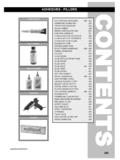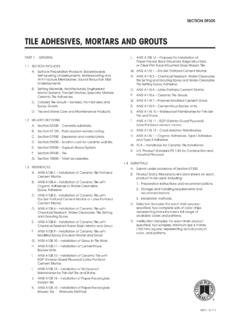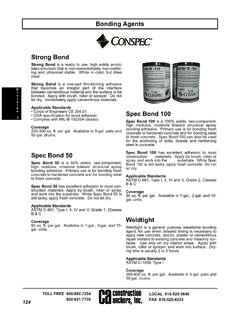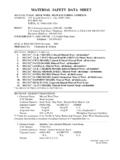Transcription of Pipe-Grip Type N Blue Solvent Cement - RLA Group
1 47 Industrial Park Drive, Lilydale VIC 3140 P: 03 9739 4311 F: 03 9739 4355 MATERIAL SAFETY DATA SHEET ISSUE No. 2 ISSUE DATE: 06/07/2012 PAGE: 1 of 7 1. PRODUCT IDENTIFICATION AND COMPANY Company: Atherton Chemicals Emergency: Poisons Information Centre Address: 47 Industrial Park Dr, Lilydale VIC 3140 Phone: 131 126 (Australia) Phone: 03 9739 4311 0800 764 766 (New Zealand) Fax: 03 9739 4355 PRODUCT NAME: Pipe-Grip type n Blue Solvent Cement PRODUCT USE: type n Solvent Cement for non-pressure joints in PVC-U Pipes and Fittings 2. HAZARDS IDENTIFICATION HAZARDOUS ACCORDING TO THE CRITERIA OF WORKSAFE AUSTRALIA Classified as Dangerous Goods according to Australian Dangerous Goods (ADG) Code. Risk Phrases: R11, R20, R36, R37, R66 and R67.
2 Highly flammable. Irritating to eyes and respiratory system. Harmful by inhalation. Repeated exposure may cause skin dryness or cracking. Vapours may cause drowsiness and dizziness. Safety Phrases: S2, S9, S16, S29, and S33. Keep out of the reach of children. Keep container in a well ventilated place. Keep away from sources of ignition NO SMOKING. Do not empty into drains. Take precautionary measures against static discharge. Health Hazards: Vapours may cause drowsiness and dizziness. This product may cause moderate irritation to the skin. Repeated exposure may cause skin dryness or cracking. The product is irritating to the eyes. HARMFUL: may cause damage if swallowed. Signs and Symptoms: Eye irritation signs and symptoms may include a burning sensation, redness, swelling and/or blurred vision. Defatting dermatitis signs and symptoms may include a burning sensation and/or a dried/cracked skin appearance. Respiratory irritation signs and symptoms may include a temporary burning sensation of the nose and throat, coughing and/or difficulty breathing.
3 If material enters the lungs, signs and symptoms may include coughing, choking, wheezing, difficulty breathing, chest congestion, shortness of breath, and/or fever. Breathing of high vapour concentrations may cause central nervous system (CNS) depression resulting in dizziness, light-headedness, headache, nausea and loss of coordination. Continued inhalation may result in unconsciousness and death. 47 Industrial Park Drive, Lilydale VIC 3140 P: 03 9739 4311 F: 03 9739 4355 MATERIAL SAFETY DATA SHEET Aggravated Medical Condition: Pre-existing medical conditions of the following organ(s) or organ system(s) may be aggravated by exposure to this product: Eyes; Respiratory system; Skin. 3. Composition/Information regarding Ingredients Ingredients CAS No. Conc., % TWA (mg/m ) STEL (mg/m ) Methyl Ethyl Ketone 78-93-3 >70% Other ingredients, which are classified as non-hazardous, to 100%.
4 Note: This is a commercial product whose exact ratio of ingredients may vary slightly. Minor quantities of other non hazardous ingredients are also possible. 4. First Aid Measures General Information: You should call the Poisons Information Centre on 13 1126 (Australia) or 0800 764 766 (New Zealand) if you feel you have been poisoned, burnt or irritated by this product. Have this MSDS with you when you call. Inhalation: Should inhalation occur, contact the appropriate Poisons Information Centre. Urgent hospital treatment may be needed. Remove the victim from the source of contamination and to fresh air. If breathing is difficult, oxygen may be beneficial if administered by trained personnel, preferably on doctor s advice. Do NOT allow victim to move about unnecessarily. Symptoms of pulmonary oedema may be delayed up to 48 hours after exposure. If in doubt, transport to the nearest medical facility. Skin Contact: Remove contaminated clothing.
5 Irritation is unlikely. However, if irritation does occur, flush with lukewarm flowing water for 15 minutes or more until irritation desists. Should any product remain on the skin after flushing it is best to allow it to dry and then it can be peeled off. Then wash with soap and water. Eye Contact: Immediately flush the contaminated eye with lukewarm flowing water for 20 minutes while holding the eyelid open. Take care not to rinse contaminated water into the other eye or over the face. Obtain medical attention immediately. Take special care if the contaminated person is wearing contact lenses. Ingestion: If the product is swallowed or gets into the mouth, do NOT induce vomiting; wash mouth water and give some water to drink. Careful note should be made that this product will expand when contacted with water. As the product gels, try to remove as much as possible from the mouth and airways. Transport the patient to the nearest medical facility.
6 If vomiting occurs spontaneously, keep the head below the hips to prevent aspiration. 47 Industrial Park Drive, Lilydale VIC 3140 P: 03 9739 4311 F: 03 9739 4355 MATERIAL SAFETY DATA SHEET 5. Fire Fighting Clear the fire area of all non-emergency personnel. Fire and explosion hazards: This product is classified as flammable. There is a risk of explosion if the product is stored in commercial quantities when in a fire. Some vapours from this product are heavier then air and may accumulate in crevices, sumps, pits or other low lying spaces. These vapours could be potentially explosive in areas of fire. Fire decomposition products from this product can include carbon monoxide if incomplete combustion occurs. Take appropriate protective measures. Extinguishing Media: Alcohol-resistant foam is the preferred extinguishing medium.
7 Water spray or foam can be used instead. Dry chemical powder, carbon dioxide, sand or earth may be used for small fires only. Try to contain spills and do not allow spillage to enter drains or waterways. Do not use a water jet. Fire Fighting: If a significant quantity of this product is involved in a fire, call the Fire Brigade. There is a danger of a violent reaction or explosion if significant quantities of this product are involved in a fire. The recommended personal protective equipment is a full fire kit with breathing apparatus. Toxic fumes may be emitted during combustion. Flash Point: -16 C Upper Explosion Limit: Lower Explosion Limit: Autoignition Temperature: 515 C Flammability Class: 3 6. Accidental Release Measures Accidental release: In the event of a major spill, prevent spillage from entering the drain or waterways. Shut off leaks, if possible without personal risks. Remove all sources of ignition in the surrounding area.
8 Use appropriate containment to avoid environmental contamination. Evacuate the spill area entry to unauthorized or unprotected personnel. Immediately call the Fire Brigade. Wear full protective clothing including face shield, gauntlet gloves and self contained breathing apparatus. See section 8 for appropriate equipment that must comply with these standards. If there is any chance of vapour build up a full face shield is recommended. Usually, a respirator is not necessary when using this product. Stop any leak if it is safe to do so and contain the spill. Suitable absorbent materials include sand and vermiculite. In cases of large spillage, turn all sources of ignition off and create a dam or 47 Industrial Park Drive, Lilydale VIC 3140 P: 03 9739 4311 F: 03 9739 4355 MATERIAL SAFETY DATA SHEET dyke to prevent flow from entering drains.
9 Collect and recover all material and return to empty labeled containers. Dispose of according to Local Waste regulations. Should product enter the drains Emergency Services should be informed. Launder all safety equipment before re-use. 7. Handling and Storage Handling: Keep exposure of this product to a minimum and use only in a well ventilated area. Wash thoroughly after handling. Follow the advice given under storage and section 8 (personal protection). Avoid contact with the skin. Beware of electrostatic charges which can lead to fire. Storage: Store in a cool well ventilated area. Do not store near sources of ignition. Do not store with aerosols, oxidizing agents, corrosive agents, compounds toxic to man or the environment. Periodically check the containers for leakage. Containers should be kept closed when not in use. Check section 10 for further conditions to avoid. 8. Personal Protection The following Australian Standards will provide general advice regarding safety clothing and equipment: Respiratory Equipment: AS/NZS 1715, Protective Gloves: AS 2161, Industrial Clothing: AS 2919, Industrial Eye Protection: AS 1336 and AS/NZS 1337, Occupational Protective Footwear: AS/NZS 2210.
10 Exposure Limits TWA (ppm) STEL (ppm) Methyl Ethyl Ketone 150 300 (SEE SECTION 3) No special equipment is usually needed when occasionally handling small quantities. The following instructions apply to bulk handling or where regular exposure occurs without proper containment systems. Ventilation: The product should only be used where there is adequate ventilation to keep exposure below the TWA levels. Eye Protection: Protective safety glasses or goggles should be worn when using this product. Failure to protect the eyes may result in harm. Emergency eye wash should be available where the product is used. Skin Protection: Information indicates that the product is not harmful to the skin for most people. However, we suggest that as with handling any chemical suitable gloves should be used when skin contact is possible. For the best skin protection, use butyl rubber or polyvinyl alcohol gloves. Protective Clothing: We suggest that protective overalls are worn while handling any chemical.



